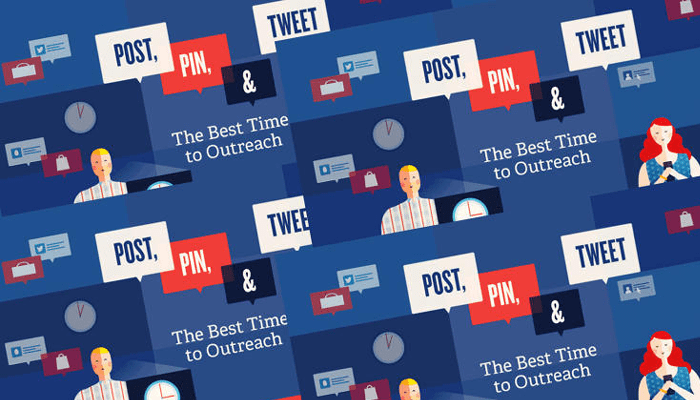Different post on social media sites offer different virtues for your business. Here’s how to optimize each one based on when you post. I get it, managing your business’s social media accounts can be daunting from tweaking tweet lengths to mastering Facebook tone to using the right hashtags at the right times.
But what savvy social media users know is that there’s a science to getting it right. If you follow certain parameters, you’re almost guaranteed to get the results you were working toward. All it takes is some knowledge and forethought, and anyone can be well on their way to posting engaging content.
Here are a few takeaways from each major social media site:
1. Times to Post on Social Media Sites
Post On Social Media Facebook During The Afternoon Slump
Most people need some motivation to get through the afternoon slump, and for many of us, that means checking Facebook. Posting to Facebook between 1 p.m. and 4 p.m. results in the highest average click-through rates. These numbers peak around 3 p.m. and hit rock bottom on weekends, before 8 a.m., and after 8 p.m. when people presumably have better things to do.
For more on managing your social media Facebook account, check out these six rules:
Don’t Oversell Yourself
No one wants to be incessantly sold to. Provide your fans with compelling content like articles that relate to your industry. When engagement declines, so does news-feed presence due to decreased sales pitch interest.
Respond To Comments
The beauty—and curse—of Facebook is that your fans can freely speak their minds. If you do get negative feedback—and you almost certainly will—don’t bury your head in the sand. Respond quickly and honestly, and you may be able to turn that frown upside down.
Keep It Short And Sweet
Max out your Facebook posts with 80 characters, but try to aim for the magic number: 40. According to Jeff Bullas’s study of retail brands on Facebook, 40-character posts received 86% higher engagement than others.
Recruit True Fans
When it comes to your social media Facebook fans, quality trumps quantity. “Fan farms” that get paid to generate fans for the lowest dollar amount will give you exactly what you paid for and nothing more.
Ask Questions
Questions generate a lot more comments, especially when they contain the words “should,” “would,” “which,” and “who.” Questions with words like “why” and “how” garner less, likely because they make users think more to articulate their answers.
Don’t Annoy Your Fans
Most of the time, fans respond positively to posts. But 2% of the time, a fan will respond with negative feedback ranging from hiding your post to unliking your page. In these instances, your fans are most likely to block all your page content. This means that you may have a lot of fans out there who never actually see your page content.
Schedule Tweets For Lunchtime
Tons of people are checking in on the Twitter sphere around lunchtime, with peak posting days falling between Monday and Thursday. But once 3 p.m. on Friday rolls around, people have officially checked out.
No One Is Checking Linkedin On A Friday
It appears that when people are winding up and winding down their workweek they have less interest in what’s happening on LinkedIn. Midweek around noon and 5 p.m. sees the most engagement.
Now that you know the best times to post to LinkedIn, it’s time to figure out where and how:
LinkedIn isn’t just an excellent way to stalk hiring managers anymore. Over the years, the social networking site has transitioned from a virtual Rolodex and resume to the mothership of all things professional.
By rolling out several features for businesses, LinkedIn has paved the way for companies to start engaging their customers better by providing compelling content.
Lana Khavinson, Small Business Segment Marketing Lead at LinkedIn, says most people who come to LinkedIn already have a professional mindset, and they are looking for all kinds of content—from articles and blog posts to infographics and charts—that will help them with their current role or that will help them further their career.
So it’s important to consider what information you can provide that will help them with their current or future endeavors and will keep you at the top of their minds when they are at a point of need. This can include content like best practices, tips, trends, and industry thought leadership pieces.
But it’s not enough to simply create great content. To get potential customers to notice you, you need to promote it the right way. Here are four insider tips to bring your content to the masses:
Build Out Your Profile Pages
It all starts with building out a robust profile, Khavinson says. Engage your network of professional connections with targeted updates and shoot for viral distribution.
Similarly, you can make the most of your company page by creating a dialogue with your followers through content and updates. Khavinson says it’s also important to think beyond your immediate network and follower base.
“It’s not just about who you know, but who they know,” she says.
To reach beyond your network, focus on posting thoughtful content relevant to your industry and business. And remember that the updates you post are going to come through users’ feeds with all kinds of other updates.
Think about how you can stand out from the crowd. Make your update engaging, use descriptive imagery, give it that spin that will draw people in, and make sure your images are visually compelling and clear.
“You should experiment and test what gets the best engagement,” Khavinson says, “but tried and true is a powerful image, a short description, and a url link.”
For example, AmeriFirst Home Mortgage successfully harnessed its company page when it created a full profile, built up its follower base, and began posting content full of advice and tips for people in the market for a home. Their content ranges from relevant industry news to thought leadership pieces.
By becoming a helpful resource for its followers, AmeriFirst maintained a consistent presence in online conversations and positioned itself at the top of mind for potential customers, thereby generating more leads.
It has since seen visits to the company website more than 25 times what it saw in 2011.
Join And Become Active In LinkedIn Groups
There are many uses for LinkedIn Groups, but top among them is its ability to get your voice out there and help you build relationships and engage with not only like-minded individuals but with potential customers.
Groups can be used to join conversations, start discussions, or create your own group.
Wanting to connect with Balihoo’s target audience, Shane Vaughan, the marketing automation startup’s former CMO, tapped into LinkedIn Groups by creating his own.
By forming his own local marketing automation group, Vaughan was able to build out a rich audience with potential customers interested in their solutions, generate leads, and identify potential partners, who would in turn build out an even broader audience.
“I was able to speak to a very specific audience, instead of having to go wider with a generic message,” Vaughan told LinkedIn.
Apply For Social Media LinkedIn’s Publishing Platform
You can join the ranks of thought leaders like Richard Branson and President Barack Obama, who began publishing blog posts on LinkedIn in the fall of 2012.
In February, LinkedIn opened its publishing platform to members who want to post blog-style content.
Currently, you have to apply for access to the publishing platform, and you can do so here. Also, when filling out the form, you will need to provide two examples of professional content you’ve written.
With access to the publishing platform, you can post longer-form pieces directly to your network, which helps with viral distribution.
Once you are granted access, simply go to the “Share an update” box on your LinkedIn homepage and click the “Edit” icon. This will take you to the writing tool, where you can write your post and include visuals (by clicking the camera icon in the tools panel on the right). Once you are finished, you can publish, save, or preview your blog.
The content will appear in followers’ news feeds and may feature in LinkedIn channels based on specific criteria.
“It gets you out there in terms of someone who is on the cutting edge,” Khavinson says.
LinkedIn even provides access to the stats for each post. You can access these by clicking “Profile” at the top of your homepage, scrolling down to your “Posts” section, and then clicking on a specific post. Click “See your posts” and stats on the right to reach your dashboard page.
Consider Buying Into Sponsored Updates
While most content engagement happens through LinkedIn’s free services detailed above. Khavinson believes that Sponsored Updates, LinkedIn’s paid-for marketing tool allows entrepreneurs to get their content noticed across the network and target specific audiences.
Sponsored Updates appear in members’ homepage feeds alongside organic posts from their network and the companies they follow. Unlike content you post yourself for free however, they will be marked “sponsored.”
From May to June last year, PC company Lenovo targeted audiences with Sponsored Updates that fell into four theme categories: brand, thought leadership, products, and external trends. They then optimized the content based on the reactions they got from different audiences.
Lenovo’s Director of Digital and Social Center for Excellence Rod Strother told LinkedIn that its Sponsored Updates drove a 17% increase in brand favorability and quadrupled its engagement rates compared to display ad averages.
“That’s going to be important for us,” he says, “because we’re going to be able to take a lot of the verbatims and comments that were made into some research that we’re doing in the future around touch products.”
2. Times to Post on Social Media Pinterest, Tumblr, Google+
Pinterest Is For Daydreaming (And Weekends)
Pinterest social media users are checking out home organization hacks. Delicious recipes, and dream purchases more on the weekends, especially first thing on Saturday. Their work-hour willpower is strong, making it the worst time to share on Pinterest.
More of the site’s users engage with brands and retailers than Facebook’s. So what makes Pinterest quite possibly the best-selling engine ever devised? CEO Ben Silbermann has some thoughts.
Tumblr Is For Night Owls
Tumblr users are more of the night owl variety. Some of the best times to post are between 7 p.m. and 10 p.m. Post anytime before 4 p.m. if all you want is crickets.
Google+ Users Check In First Thing In The Morning
Unlike Tumblr, Google+ users are early birds. The most engagement comes from content that is posted first thing in the morning.
One consideration worth noting when scheduling your content is how different time zones could play into your timing. It might be worthwhile to base your post-timing decisions on what time zone your largest demographic falls into.



